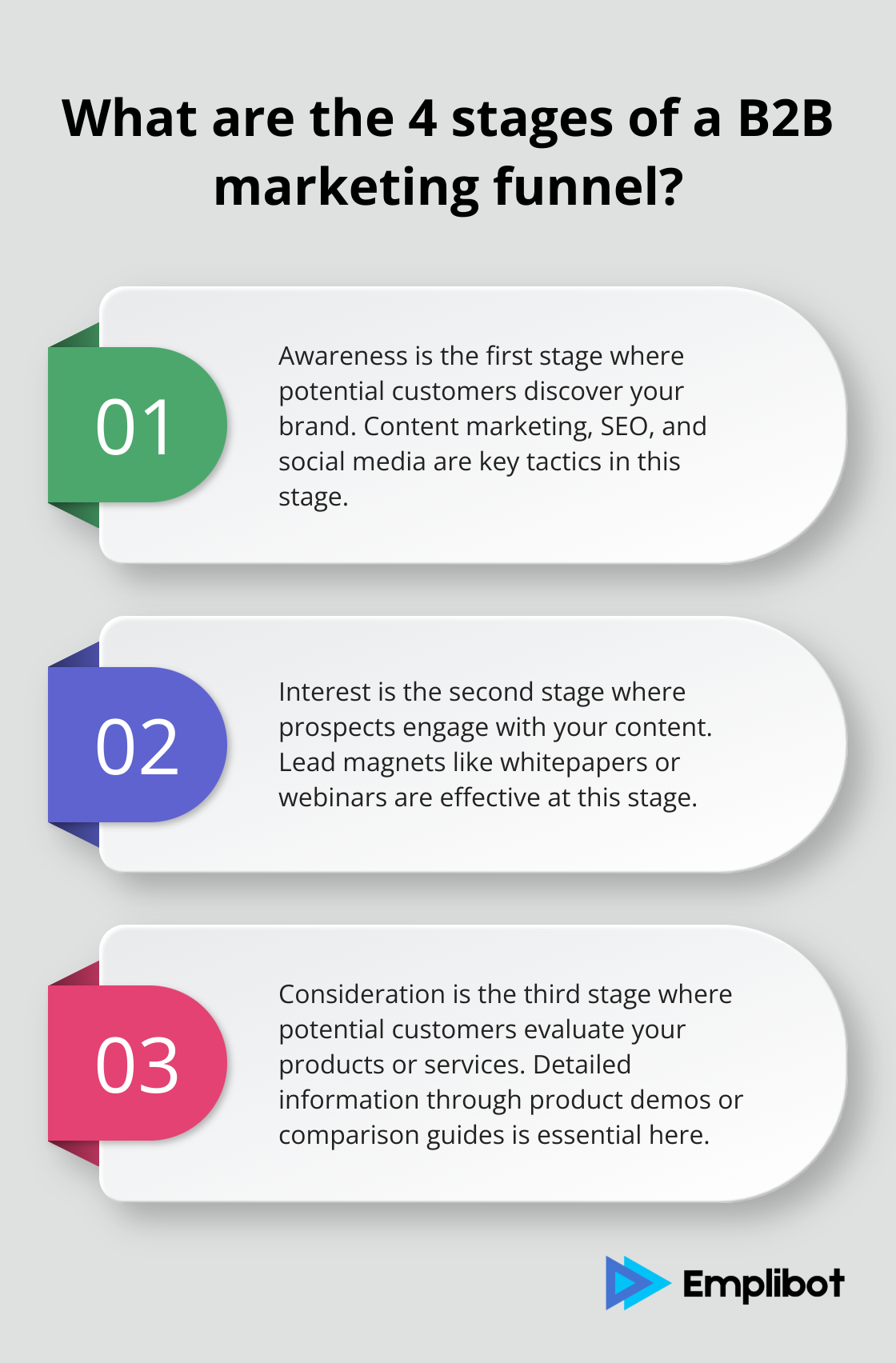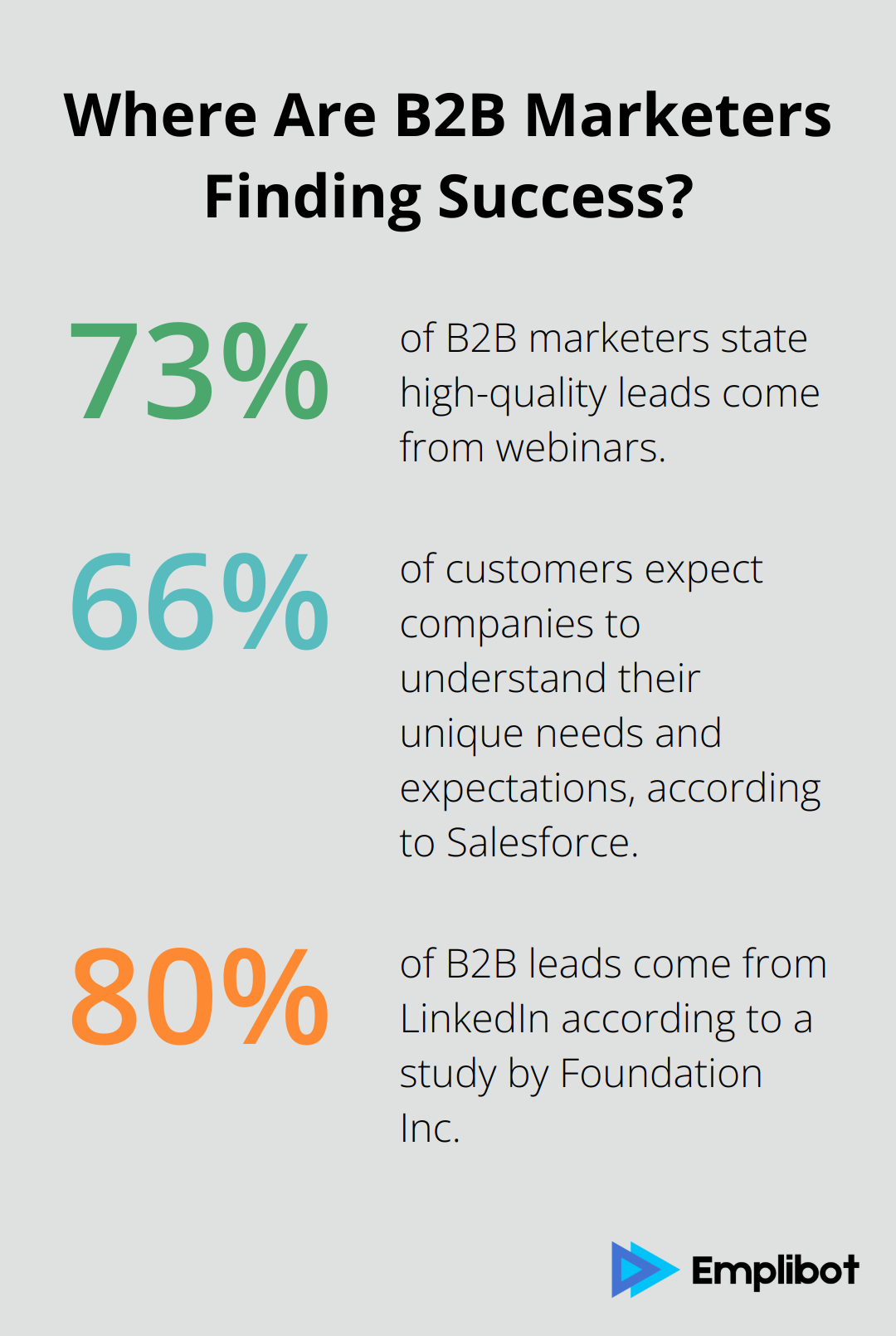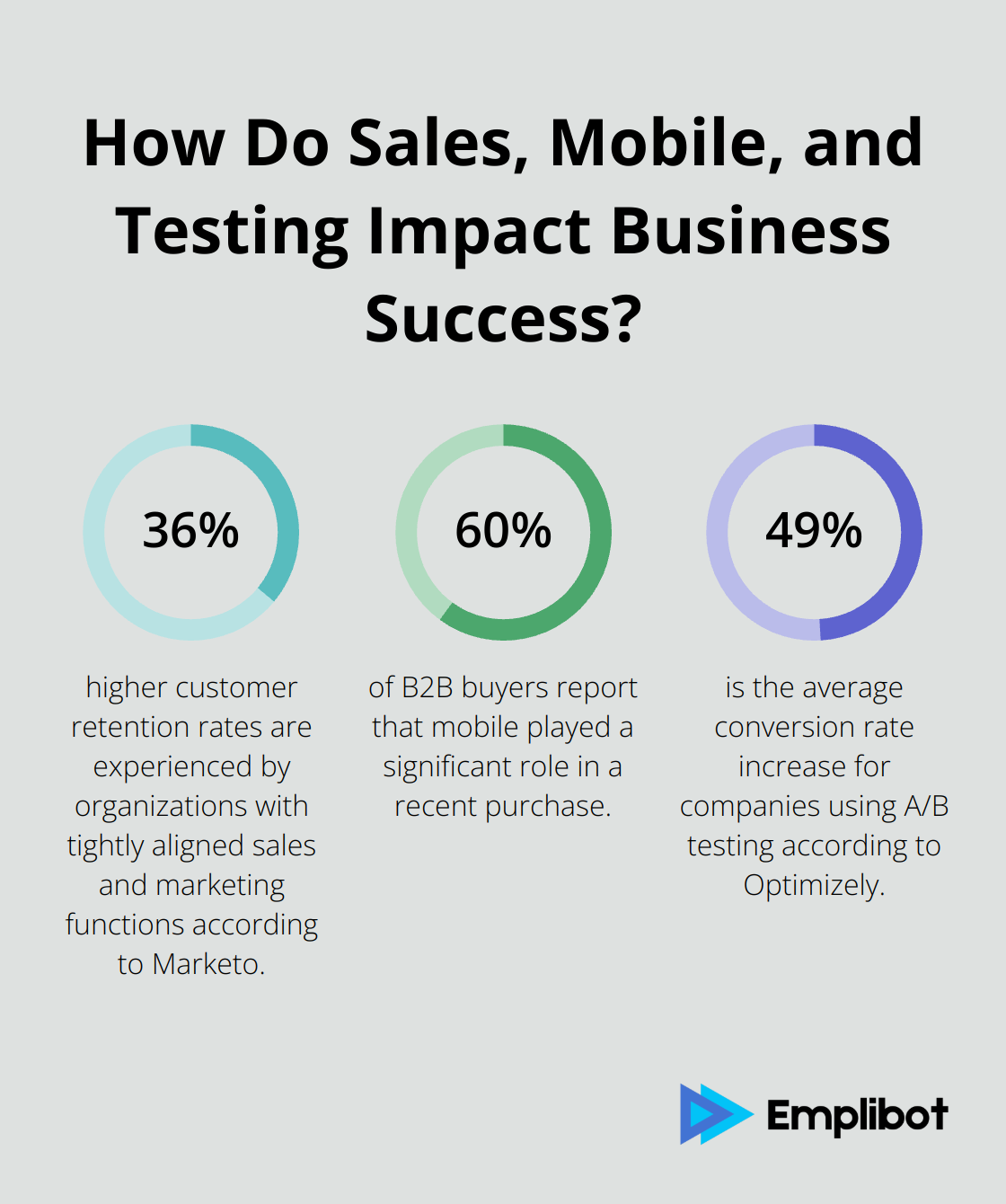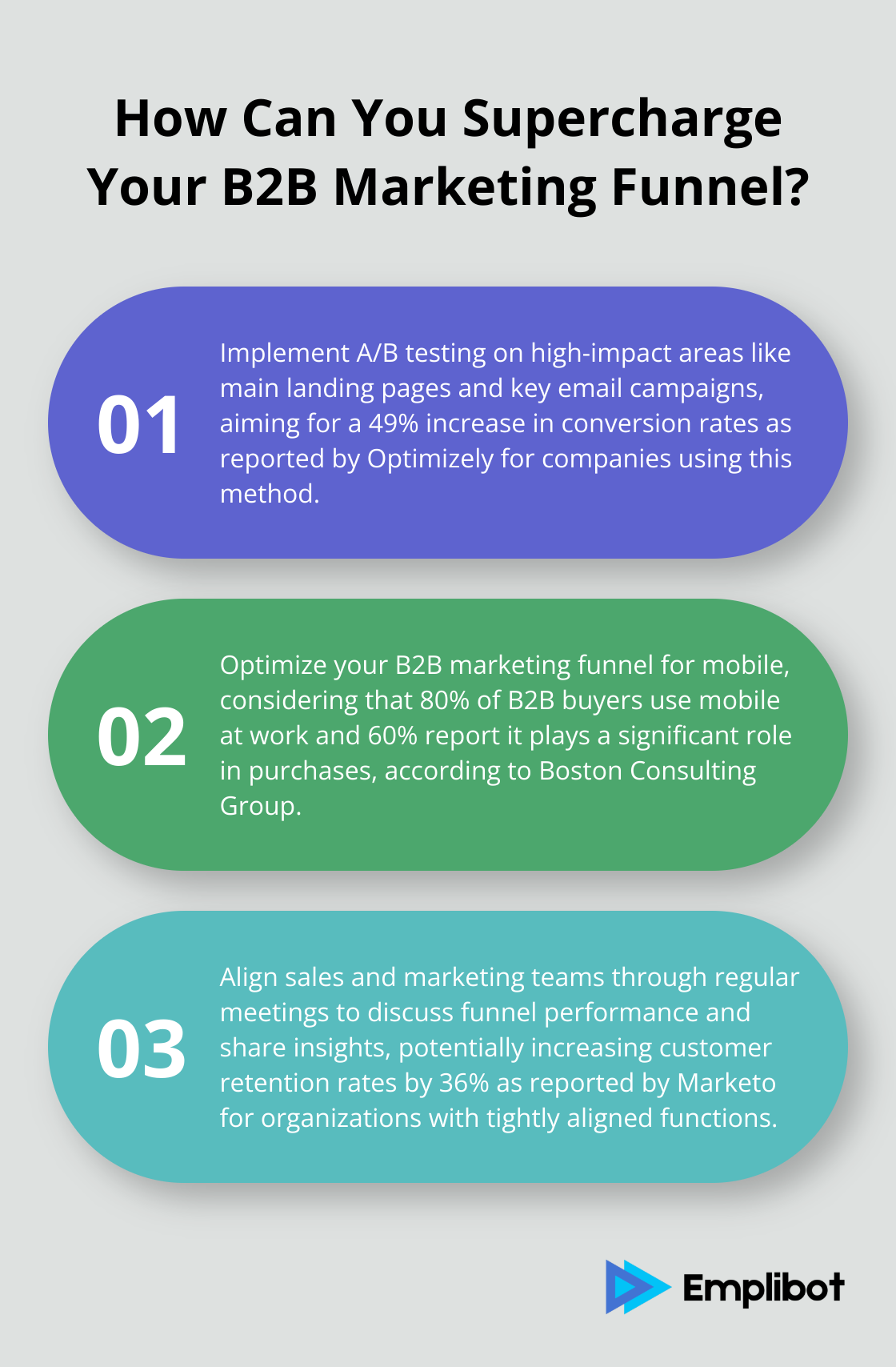B2B marketing funnels are the backbone of successful lead generation and conversion strategies. At Emplibot, we’ve seen firsthand how a well-crafted funnel can transform a company’s marketing efforts.
In this post, we’ll break down the key stages of a B2B marketing funnel and provide actionable strategies for each step. We’ll also share tips on measuring and optimizing your funnel for maximum impact.
What Is a B2B Marketing Funnel?
Definition and Key Components
A B2B marketing funnel consists of the various stages a customer goes through; from discovering your brand to making a purchase. This tool streamlines marketing efforts and boosts conversions for businesses.
The Four Stages of a B2B Marketing Funnel
- Awareness: Potential customers first learn about your brand. Content marketing, SEO, and social media are key tactics in this stage.
- Interest: Prospects start to engage with your content and show interest in your offerings. Lead magnets like whitepapers or webinars prove effective here.
- Consideration: Potential customers actively evaluate your products or services. Detailed information through product demos or comparison guides is essential.
- Decision: The final stage where prospects decide whether to make a purchase. Personalized offers and ROI calculators can influence decisions favorably.
B2B vs B2C: Notable Differences
B2B marketing funnels differ significantly from their B2C counterparts. The B2B sales cycle typically lasts longer, involves multiple decision-makers, and requires more in-depth information at each stage.

B2B purchases also tend to be higher-value and more complex, necessitating a focus on building trust and demonstrating expertise throughout the funnel. Content marketing plays a vital role here.
Tailoring Your Funnel for Success
To create an effective B2B marketing funnel, you must understand your target audience intimately. Develop detailed buyer personas and map out their specific pain points and needs at each stage of the funnel.
Use data to inform your strategy. Tools like Google Analytics (and Emplibot for content creation and distribution) can help you track user behavior and identify where prospects drop off in your funnel. This insight allows you to optimize your approach and improve conversion rates.
A well-crafted B2B marketing funnel requires constant refinement based on performance data and changing market conditions. Continuous optimization of your funnel ensures that your marketing efforts always align with your business goals and customer needs.
Now that we’ve established what a B2B marketing funnel is and its key components, let’s explore specific strategies for each stage of the funnel to maximize its effectiveness.
Winning Strategies for Each Funnel Stage
Awareness: Cast a Wide Net
In the awareness stage, your goal is to attract potential customers who may not know they have a problem you can solve. Content marketing takes center stage here. Create blog posts, infographics, and videos that address common industry pain points. A SaaS company might create a series of blog posts about productivity challenges in remote teams.
SEO plays a vital role in discoverability. Use tools like SEMrush or Ahrefs to identify high-volume, low-competition keywords relevant to your industry. Incorporate these naturally into your content to improve organic search rankings.

Social media amplifies your reach. LinkedIn proves particularly effective for B2B, with 80% of B2B leads coming from this platform (according to a study by Foundation Inc). Share your content, engage in industry discussions, and use hashtags strategically to increase visibility.
Interest: Nurture Potential Leads
Once you’ve captured attention, nurture that interest with valuable resources. Lead magnets like whitepapers, e-books, or templates can be powerful tools. A marketing automation company might offer a free template for creating a content calendar.
Webinars excel at showcasing expertise and building trust. 73% of B2B marketers state high-quality leads come from webinars. Choose topics that address specific pain points in your industry and provide actionable takeaways.
Case studies demonstrate real-world value. Share detailed accounts of how your product or service solved problems for existing clients. Include specific metrics and results to make your case studies more compelling.
Consideration: Prove Your Worth
At this stage, potential customers actively evaluate your offering. Product demos are essential here. Gong.io found that successful demos that lead to closed deals are 36% longer than unsuccessful ones, suggesting that thorough explanations pay off.
Free trials allow prospects to experience your product firsthand. Salesforce discovered that 66% of customers expect companies to understand their unique needs and expectations. A trial period gives them a chance to see how well you meet those needs.
Comparison guides help prospects understand how you stack up against competitors. Be honest about your strengths and weaknesses. Transparency builds trust and shows confidence in your offering.
Decision: Seal the Deal
In the final stage, personalization is key. Tailor your offers to the specific needs and pain points of each prospect. Salesforce reports that 72% of B2B customers expect vendors to personalize engagement to their needs.
ROI calculators provide concrete evidence of your value. Create a tool that allows prospects to input their own data and see potential returns. This tangible demonstration of value can be the tipping point for many decision-makers.
Testimonials offer social proof. BrightLocal found that 91% of B2B buyers are influenced by word-of-mouth recommendations. Feature testimonials from satisfied customers, especially those in similar industries or with similar challenges to your prospect.
These strategies form the foundation of an effective B2B marketing funnel. However, to truly maximize your funnel’s potential, you need to measure its performance and continuously optimize each stage. Let’s explore how to track and improve your funnel’s effectiveness in the next section.
How to Measure and Optimize Your B2B Marketing Funnel
Track Essential KPIs
Each stage of your B2B marketing funnel requires different metrics to gauge its effectiveness. For the awareness stage, focus on metrics like website traffic, social media engagement, and content views. A study found that 58% of B2B marketers rate their content strategy as merely “moderately effective.”

In the interest stage, look at metrics such as email open rates, click-through rates, and lead magnet downloads. HubSpot reports that the average email open rate for B2B companies is 30.5%. Try to exceed this benchmark.
For the consideration stage, track demo requests, free trial sign-ups, and time spent on product pages. Totango found that companies with a free trial conversion rate of 25% or higher rank in the top quartile of SaaS businesses.
In the decision stage, focus on conversion rates, deal size, and sales cycle length. According to Databox, the median B2B sales cycle length is 2.1 months (but this can vary widely depending on your industry and product complexity).
Leverage Analytics Tools
To effectively track these KPIs, you need robust analytics tools. Google Analytics remains a powerhouse for website analytics, offering insights into traffic sources, user behavior, and conversion paths.
For more comprehensive funnel tracking, consider tools like Mixpanel or Amplitude. These platforms allow you to create custom funnels and track user progression through each stage.
CRM systems like Salesforce or HubSpot can provide valuable insights into lead quality and sales performance. They allow you to track interactions across the entire customer journey, from first touch to closed deal.
Implement Continuous Improvement
Once you have data on your funnel performance, it’s time to optimize. A/B testing is a powerful method for incremental improvements. Test different elements of your funnel, such as email subject lines, landing page designs, or call-to-action buttons.
Optimizely reports that companies using A/B testing see an average conversion rate increase of 49%. Start with high-impact areas like your main landing pages or key email campaigns.
Don’t forget to optimize for mobile. Boston Consulting Group reports that 80% of B2B buyers use mobile at work, and more than 60% report that mobile played a significant role in a recent purchase.
Regularly review your content strategy. Analyze which types of content perform best at each funnel stage and double down on what works. If certain pieces consistently underperform, consider updating or replacing them.
Align Sales and Marketing Teams
Ensure your sales and marketing teams work together closely. According to Marketo, organizations with tightly aligned sales and marketing functions experience 36% higher customer retention rates. Regular meetings to discuss funnel performance and share insights can lead to significant improvements in conversion rates.
Final Thoughts
An effective B2B marketing funnel requires careful planning and execution. You must tailor your strategies to guide potential customers through each stage of their buying journey. Provide value at every touchpoint, from informative blog posts to compelling case studies.

B2B marketing funnels are not one-size-fits-all solutions. You need to customize them to your specific industry, target audience, and business goals. Regular analysis of performance metrics and A/B testing will help you identify areas for improvement and optimize your funnel’s impact.
A well-crafted B2B marketing funnel can differentiate between stagnation and growth in today’s competitive landscape. Implement the strategies outlined in this post and continuously refine your approach. You’ll attract, nurture, and convert high-quality leads into loyal customers.

